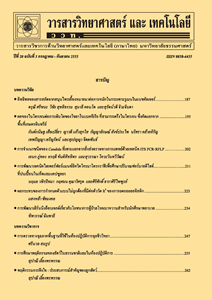การพัฒนาคุกกี้หน่อกะลา (Alpinia nigra Burrt) ปราศจากกลูเตน
Main Article Content
Abstract
This research aimed to optimize the formula to produce gluten-free Alpinia nigra Burrt cookies. The seven formulations of gluten-free A. nigra cookies consisting of A. nigra (5-12 %), wheat flour (30-50 %) and salted butter (25-45 %) were studied by using mixture design. Physical properties and sensory evaluation by untrained panelists were investigated. The results showed that weight loss of cookies varied directly to the amount of butter. The hardness and the brightness of cookie varied directly to the amount of A. nigra. Obviously, an optimal formulation of the gluten-free cookies was 10 % A. nigra, 47 % wheat flour and 43 % salted butter. This formulation had the highest score of appearance (7.17±1.02), flavor (7.17±0.79), texture (7.03±0.89), taste (7.13±0.97) and overall liking (7.33±0.88). Furthermore, using various types of flour replacement with wheat flour was studied. The results discovered that cookies made from mixed flour (contain 65 % of rice flour, 25 % of potato flour and 10 % of cassava flour) were the most suitable formula for wheat flour replacement. Apparently, physical properties (weight loss) and sensory evaluation score (appearance, flavor, texture, taste and overall liking) of cookies made from mixed flour formula were similar to that from wheat flour formula. Therefore, gluten-free A. nigra cookie is an alternative product for consumers who want to avoid gluten foods.
Article Details
References
[2] Pratuangdejkul, A., 2009, Orchid ginger, Med. Plant Newslett. 26(2): 12-17. (in Thai)
[3] Thai Industrial Standards Institute, 2012, Community Product Standards: Cookie (118/2555), Available Source: https://www.tisi.go.th, July 1, 2018. (in Thai)
[4] Surojanamethakul, V. and Hiraga, C., 2013, Coeliac disease and importance of the gluten-free food, Food 43(3): 16-21. (in Thai)
[5] Duncan, D.B., 1995, Multiple range and multiple F tests, Biometrics 11: 1-42.
[6] Charoenphun, N. and Kwanhian, W., 2018, Effect of flour from durian waste on quality of gluten free pasta, Thai J. Sci. Technol. 26(5): 803-814. (in Thai)
[7] Rattanapanone, N., 2006, Food Chemistry, Odeon Store, Bangkok, 504 p. (in Thai)
[8] Budzaki, S., Komlenic, D.K., Cacic, J.L., Cacic, F., Jukic, M., and Kozul, Z., 2014, Influence of cookies composition on temperature profiles and qualitative parameters during baking, Croat. J. Food Sci. Technol. 6(2): 72-78.
[9] Ounta, N., 2013, Chemical Composition and Biological Activity from Alpinia nigra Burrt., Burapha University, Chonburi, 46 p. (in Thai)
[10] Suphamityotin, P., 2013, Fruit and Vegetable Technology, Odeon store, Bangkok, 280 p. (in Thai)
[11] Khumkhom, S., 2018, Effect of additional dried sesbania (Sesbania Javanica Miq.) flowers powder on physical, nutritional and organoleptic characteristics of butter cookies, Phranakhon Rajabhat Res. J. (Sci. Technol.) 13(1): 139-154. (in Thai)
[12] Srirod, K and Piyajomkhawn K., 2003, Flour Technology, Kasetsart University, Bangkok, 303 p. (in Thai)
[13] Boonkong, J., Bunmee, T. and Ruenkeaw, P, 2015, Application of resistant starch from unripe banana “Hom Thong” (Musa sapientum L., AAA group) in pasta, J. Food Tech. Siam Univ. 10(1): 19-29. (in Thai)
[14] Vimala, B., Nambisan, B. and Hariprakash, B., 2011, Retention of carotenoids in orange-fleshed sweet potato during processing, J. Food Sci. Technol. 48: 520-524.
[15] Tantakasem, S. and Ruangchai, S., 2011, Using ground peanuts as a fat substitute in cookies, Univ. Thai Chamber Commerce J. 13(2): 114-125. (in Thai)
[16] Srisayam, M., Weerapreeyakul, N. and Sribuarin, P., 2014, In vitro antioxidant activity of white, black and red sesame seeds, Isan J. Pharm. Sci. 10(2): 136-146. (in Thai)


